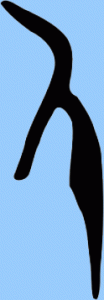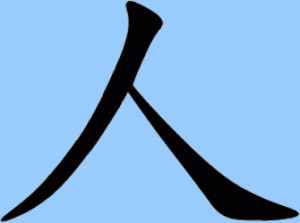Let’s briefly examine the history of Chinese characters.
The earliest known appearance of many of the Chinese characters dates from the late Shang dynasty, for a couple hundred years until the end of the Shang dynasty around 1150 B.C. These are called Oracle Bone script. In Chinese, these are called jiǎgǔwén (甲骨文). Jiǎgǔwén in Chinese means shell (甲) bone (骨) writing (文), as this writing appeared on turtle shell and animal bones. These were primarily used for divination. The below character is a picture of a person, facing the left. We can see the head, the arms facing left, and the body and legs.
Oracle Bone Script
Divination on bone went out of style with the next dynasty, the Zhou. The primary writing from that period was on bronze, and so the writing during this period is called Bronze inscriptions, 金文 (jīnwén).
Bronze Inscription
These were followed by what are known as seal scripts. During the warring states period, each area had its own form of seal script. At this time, it was called Large Seal script, 大篆 (dàzhuàn). Writing was unified under the Qin dynasty, 200 BC, during which time it was called Small Seal script, 小篆 (xiǎozhuàn). Few can read Seal script today, and it is mostly only used engraved on seals.
During the Han dynasty, which followed the Qin, what is called Clerical script became common. It is called this because characters were standardized and stylized so that clerks could copy them quickly and accurately, and they would be easier to read. These characters are quite similar to modern characters.
With the end of the Han dynasty in about 200 A.D., so-called Standard script came into popular use. This has lasted until today, and is now called traditional characters. There were other forms of writing in use as well, such as cursive forms, but this standard script has endured.
Modern Script
In the 1950’s, Mao ZeDong simplified the Chinese characters in order to enable more people to learn to read. For this simple character, the simplified form is not different from the traditional form. Many characters are quite different.
Simplified Chinese is used in mainland China. Traditional characters are used outside of China proper, such as in Taiwan and Hong Kong.
With few exceptions, the characters that will be discussed here are the traditional characters, since the simplified characters have often been simplified to the point that the original pictures can be too difficult to discern.
Chinese characters have changed quite a bit over the past 3,500 years. In other words, they have evolved, and have become more refined and more stylized. Many characters have well understood etymologies, or origins. The origins of other characters are more controversial.
In some cases, many people will disagree with my description of etymologies here. That is ok with me. There is often much room for interpretation. Such people often believe that as characters evolved, it is pure coincidence that the modern forms just happen to look like pictures that they did not originally, as though those using the characters as they evolved somehow failed to notice the new relationships as they shaped changes in characters. I do not think that this is the case. Anyway, characters are often quite abstract, and like abstract art are open to interpretation. If you go to the art museum and observe a piece of abstract art, how meaningful is it for someone to tell you that what you see is not really there; but only looks like it is there.
Ultimately, if we look inside a character and see a picture that relates to its meaning, then the character has more meaning to us than a random bunch of pen strokes would. I recommend that you too learn to search for the pictures within the Chinese pictographs.
Most complex characters are combinations of simpler characters. It is important to learn the basic units of meaning, the basic pictures, so that we can learn to recognize complex combinations of pictures.


